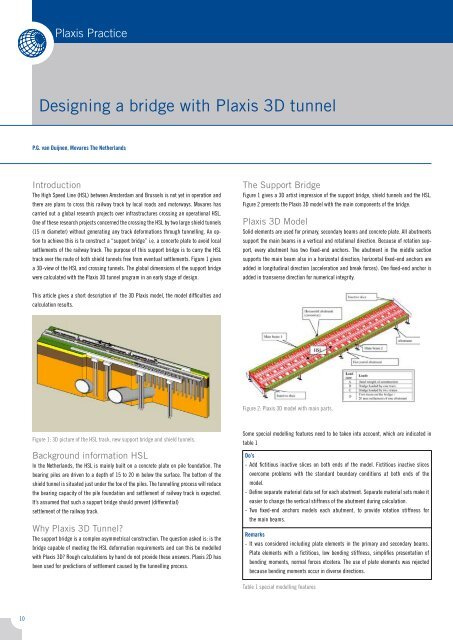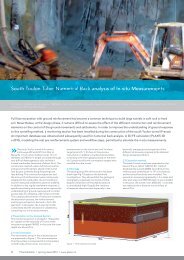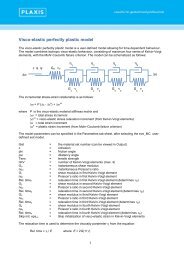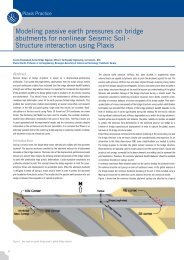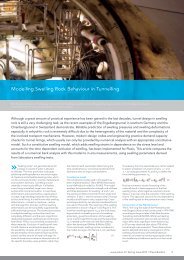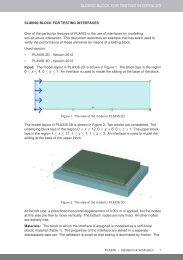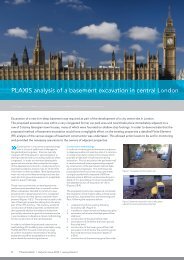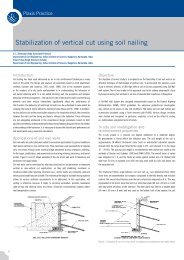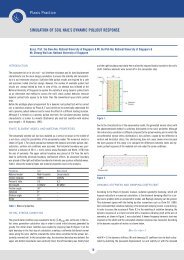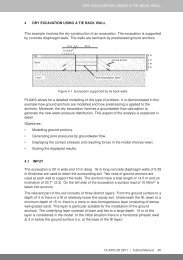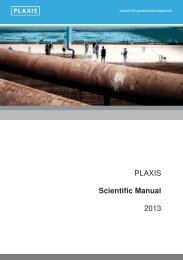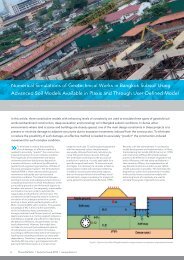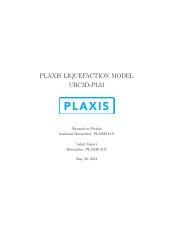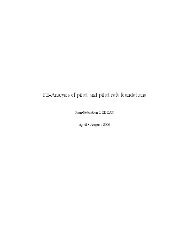Bulletin 22, Autumn 2007 - Plaxis
Bulletin 22, Autumn 2007 - Plaxis
Bulletin 22, Autumn 2007 - Plaxis
Create successful ePaper yourself
Turn your PDF publications into a flip-book with our unique Google optimized e-Paper software.
<strong>Plaxis</strong> PracticeDesigning a bridge with <strong>Plaxis</strong> 3D tunnelP.G. van Duijnen, Movares The NetherlandsIntroductionThe High Speed Line (HSL) between Amsterdam and Brussels is not yet in operation andthere are plans to cross this railway track by local roads and motorways. Movares hascarried out a global research projects over infrastructures crossing an operational HSL.One of these research projects concerned the crossing the HSL by two large shield tunnels(15 m diameter) without generating any track deformations through tunnelling. An optionto achieve this is to construct a “support bridge” i.e. a concerte plate to avoid localsettlements of the railway track. The purpose of this support bridge is to carry the HSLtrack over the route of both shield tunnels free from eventual settlements. Figure 1 givesa 3D-view of the HSL and crossing tunnels. The global dimensions of the support bridgewere calculated with the <strong>Plaxis</strong> 3D tunnel program in an early stage of design.The Support BridgeFigure 1 gives a 3D artist impression of the support bridge, shield tunnels and the HSL.Figure 2 presents the <strong>Plaxis</strong> 3D model with the main components of the bridge.<strong>Plaxis</strong> 3D ModelSolid elements are used for primary, secondary beams and concrete plate. All abutmentssupport the main beams in a vertical and rotational direction. Because of rotation support,every abutment has two fixed-end anchors. The abutment in the middle sectionsupports the main beam also in a horizontal direction; horizontal fixed-end anchors areadded in longitudinal direction (acceleration and break forces). One fixed-end anchor isadded in transverse direction for numerical integrity.This article gives a short description of the 3D <strong>Plaxis</strong> model, the model difficulties andcalculation results.Figure 2: <strong>Plaxis</strong> 3D model with main parts.Figure 1: 3D picture of the HSL track, new support bridge and shield tunnels.Background information HSLIn the Netherlands, the HSL is mainly built on a concrete plate on pile foundation. Thebearing piles are driven to a depth of 15 to 20 m below the surface. The bottom of theshield tunnel is situated just under the toe of the piles. The tunnelling process will reducethe bearing capacity of the pile foundation and settlement of railway track is expected.It’s assumed that such a support bridge should prevent (differential)settlement of the railway track.Why <strong>Plaxis</strong> 3D Tunnel?The support bridge is a complex asymmetrical construction. The question asked is: is thebridge capable of meeting the HSL deformation requirements and can this be modelledwith <strong>Plaxis</strong> 3D? Rough calculations by hand do not provide these answers. <strong>Plaxis</strong> 2D hasbeen used for predictions of settlement caused by the tunnelling process.Some special modelling features need to be taken into account, which are indicated intable 1Do’s- Add fictitious inactive slices on both ends of the model. Fictitious inactive slicesovercome problems with the standard boundary conditions at both ends of themodel.- Define separate material data set for each abutment. Separate material sets make iteasier to change the vertical stiffness of the abutment during calculation.- Two fixed-end anchors models each abutment, to provide rotation stiffness forthe main beams.Remarks- It was considered including plate elements in the primary and secondary beams.Plate elements with a fictitious, low bending stiffness, simplifies presentation ofbending moments, normal forces etcetera. The use of plate elements was rejectedbecause bending moments occur in diverse directions.Table 1 special modelling features10


